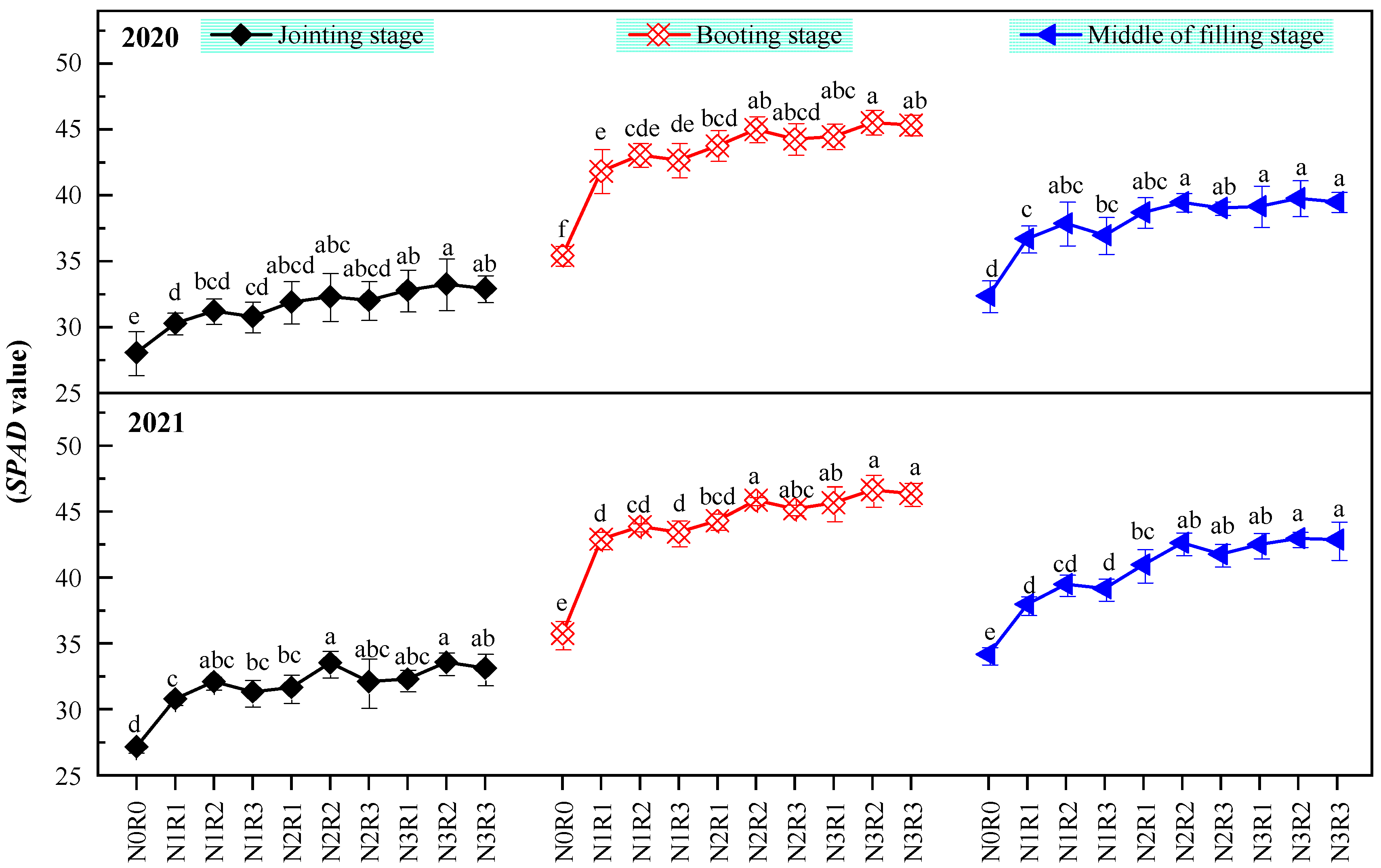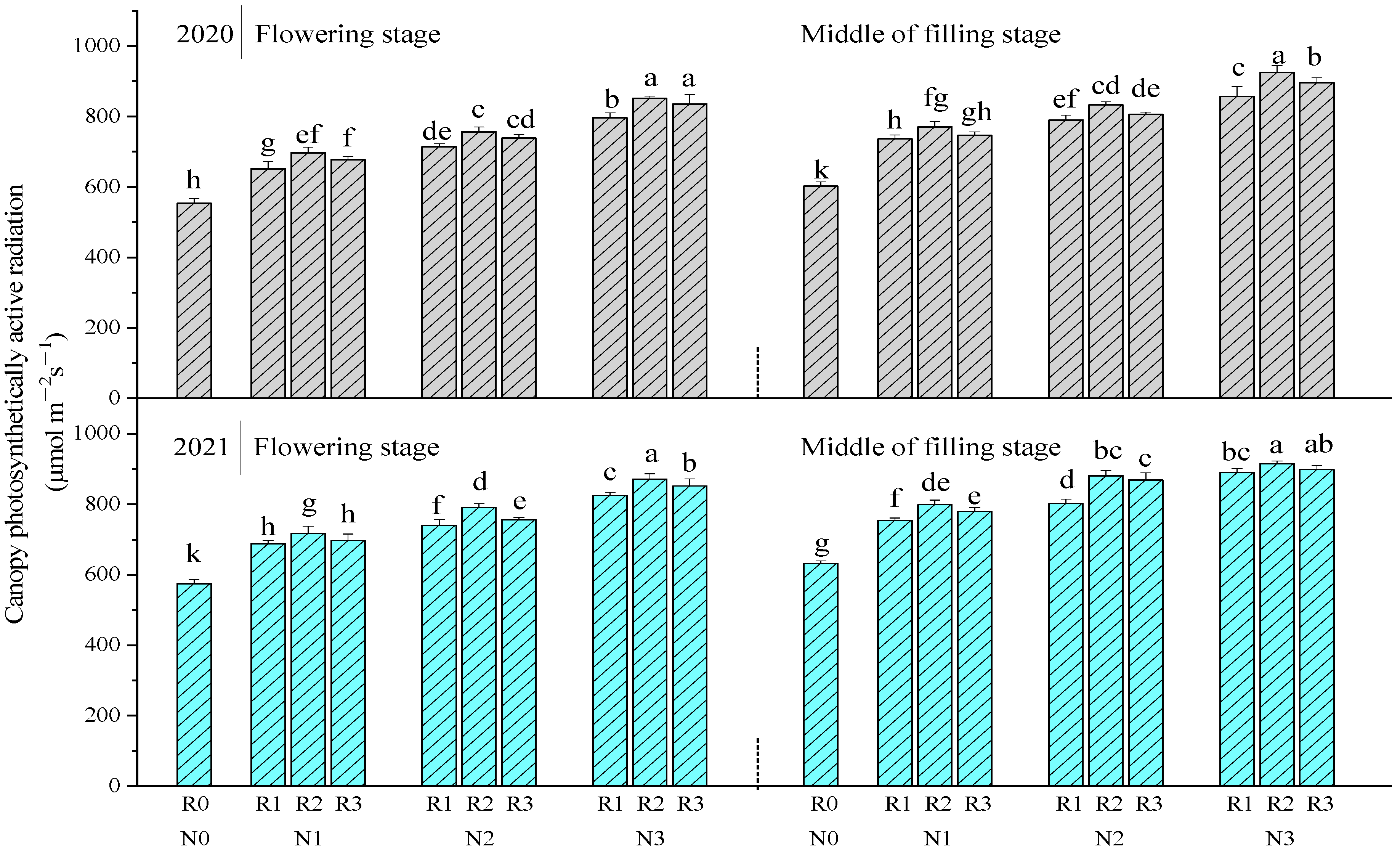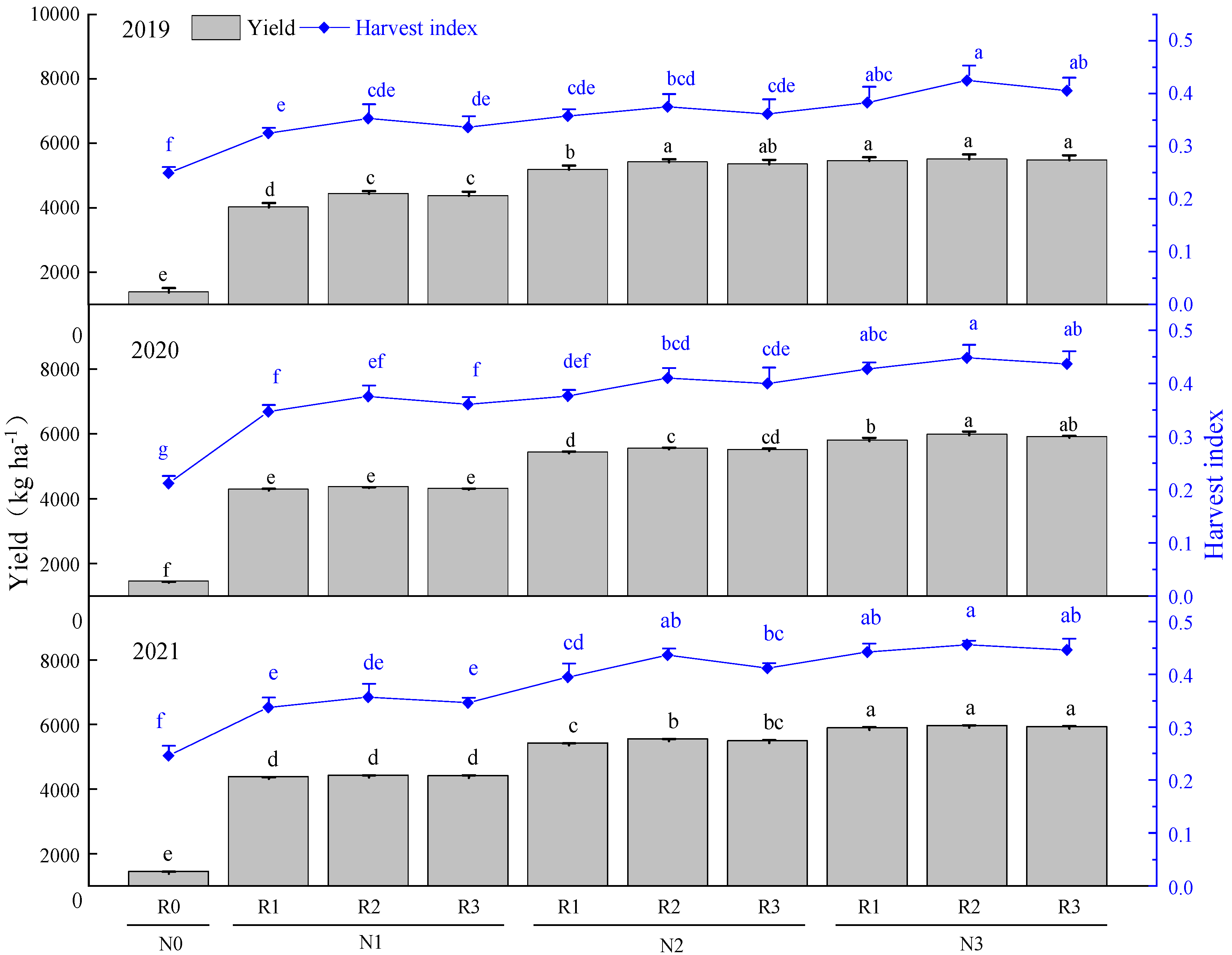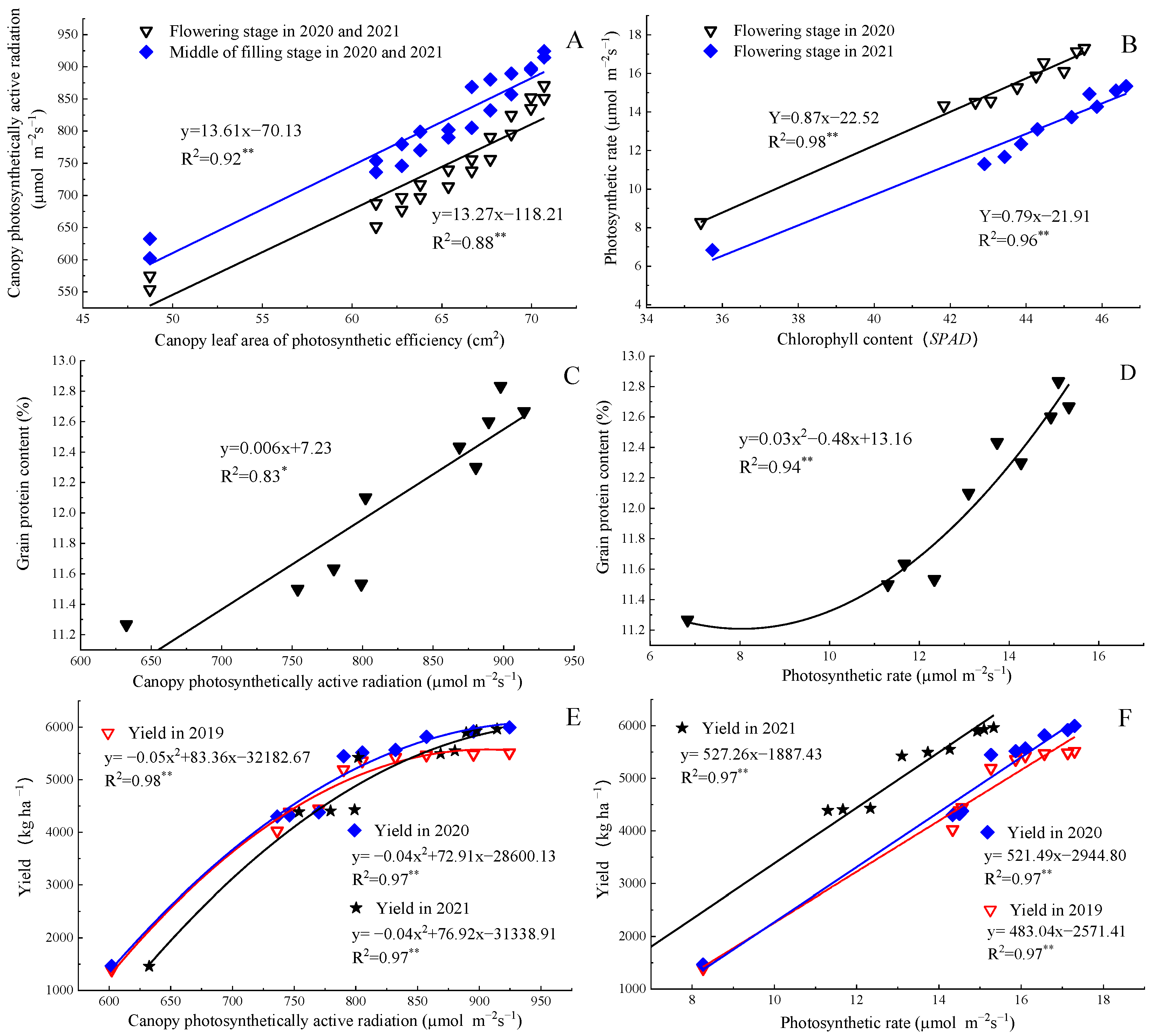Response of Canopy Photosynthesis, Grain Quality, and Harvest Index of Wheat to Different Nitrogen Application Methods
Abstract
:1. Introduction
2. Result
2.1. Effects of Nitrogen Application Method on Photosynthesis
2.1.1. Leaf Area of Photosynthetic Efficiency
2.1.2. Chlorophyll Content
2.1.3. Canopy Photosynthetically Active Radiation
2.1.4. Photosynthetic Characteristics
2.2. Effects of Nitrogen Application Method on Grain Quality
2.3. Effects of Nitrogen Application Method on Yield and Harvest Index
2.4. Correlation Analysis
3. Discussion
4. Materials and Methods
4.1. Experimental Design and Management
4.2. Sampling and Measurements
4.3. Statistical Analysis
5. Conclusions
Author Contributions
Funding
Institutional Review Board Statement
Informed Consent Statement
Data Availability Statement
Conflicts of Interest
References
- Zhu, D.; Zhang, H.; Guo, B.; Ke, X.; Dai, Q.; Wei, H.; Huo, Z. Effects of nitrogen level on yield and quality of japonica soft super rice. J. Integr. Agric. 2017, 16, 1018–1027. [Google Scholar] [CrossRef]
- Peng, S.; Buresh, R.J.; Huang, J.; Yang, J.; Zou, Y.; Zhong, X.; Wang, G.; Zhang, F. Strategies for overcoming low agronomic nitrogen use efficiency in irrigated rice systems in China. Field Crops Res. 2006, 96, 37–47. [Google Scholar] [CrossRef]
- Parry, M.A.J.; Reynolds, M.; Salvucci, M.E.; Raines, C.; Andralojc, P.J.; Zhu, X.G. Raising yield potential of wheat. II. Increasing photosynthetic capacity and efficiency. J. Exp. Bot. 2011, 62, 453–467. [Google Scholar] [CrossRef] [PubMed]
- Chakwizira, E.; Brown, H.E.; De Ruiter, J.M. Radiation-use efficiency for forage kale crops grown under different nitrogen application rates. Grass Forage Sci. 2014, 70, 620–630. [Google Scholar] [CrossRef]
- Lemaire, G.; Van Oosterom, E.J.; Jeuffroy, M.; Gastal, F.; Massignam, A. Crop species present different qualitative types of response to N deficiency during their vegetative growth. Field Crops Res. 2008, 105, 253–265. [Google Scholar] [CrossRef]
- Shangguan, Z.; Shao, M.; Dyckmans, J. Effects of nitrogen nutrition and water deficit on net photosynthetic rate and chlorophyll fluorescence in winter wheat. J. Plant Physiol. 2000, 156, 46–51. [Google Scholar] [CrossRef]
- Yang, D.Q.; Dong, W.H.; Luo, Y.L.; Song, W.T.; Wang, Z.L. Effects of nitrogen application and supplemental irrigation on canopy temperature and photosynthetic characteristics in winter wheat. J. Agric. Sci. 2018, 156, 13–23. [Google Scholar] [CrossRef]
- Li, H.; Luo, Y.; Ma, J.H. Radiation-use efficiency and the harvest index of winter wheat at different nitrogen levels and their relationships to canopy spectral reflectance. Crop Pasture Sci. 2011, 62, 208–217. [Google Scholar] [CrossRef]
- Giuliani, M.M.; Giuzio, L.; De, C.A.; Flagella, Z. Relationships between nitrogen utilization and grain technological quality in durum wheat: II. Grain yield and quality. Agron. J. 2011, 103, 1668–1675. [Google Scholar] [CrossRef]
- Dupont, F.M.; Hurkman, W.J.; Vensel, W.H.; Tanaka, C.; Kothari, K.M.; Chung, O.K. Protein accumulation and composition in wheat grains: Effects of mineral nutrients and high temperature. Eur. J. Agron. 2006, 25, 96–107. [Google Scholar] [CrossRef]
- Fowler, D.B. Crop nitrogen demand and grain protein concentration of spring and winter wheat. Agron. J. 2003, 95, 260–265. [Google Scholar] [CrossRef]
- Nyiraneza, J.; Cambouris, A.N.; Ziadi, N.; Tremblay, N.; Nolin, M.C. Spring wheat yield and quality related to soil texture and nitrogen fertilization. Agron. J. 2012, 104, 589–599. [Google Scholar] [CrossRef]
- Mueller, S.M.; Vyn, T.J. Physiological constraints to realizing maize grain yield recovery with silking-stage nitrogen fertilizer applications. Field Crops Res. 2018, 228, 102–109. [Google Scholar] [CrossRef]
- Varga, B.; Svečnjak, Z. The effect of late-season urea spraying on grain yield and quality of winter wheat cultivars under low and high basal nitrogen fertilization. Field Crops Res. 2006, 96, 125–132. [Google Scholar] [CrossRef]
- Zhao, D.; Reddy, K.R.; Kakani, V.G.; Reddy, V.R. Nitrogen deficiency effects on plant growth, leaf photosynthesis, and hyperspectral reflectance properties of sorghum. Eur. J. Agron. 2005, 22, 391–403. [Google Scholar] [CrossRef]
- Dingkuhn, M.; De Datta, S.K.; Javellana, C.; Pamplona, R.; Schnier, H.F. Effect of late-season N fertilization on photosynthesis and yield of transplanted and direct-seeded tropical flooded rice. I. Growth dynamics. Field Crops Res. 1992, 28, 223–234. [Google Scholar] [CrossRef]
- Gao, P.; Zuo, Z.; Zhang, R.; Qiu, Y.; He, R.; Gao, R.; Gui, R. Optimum nitrogen fertilization for phyllostachys edulis productivity and photosynthetic response. Agron. J. 2016, 108, 448–458. [Google Scholar] [CrossRef]
- Zhang, Y.; Wang, J.; Gong, S.; Xu, D.; Sui, J. Nitrogen fertigation effect on photosynthesis, grain yield and water use efficiency of winter wheat. Agric. Water Manag. 2017, 179, 277–287. [Google Scholar] [CrossRef]
- Lamptey, S.; Li, L.; Xie, J.; Zhang, R.; Yeboah, S.; Antille, D.L. Photosynthetic response of maize to nitrogen fertilization in the Semiarid Western Loess Plateau of China. Crop Sci. 2017, 57, 2739–2752. [Google Scholar] [CrossRef]
- Blandino, M.; Marinaccio, F.; Vaccino, P.; Reyneri, A. Nitrogen fertilization strategies suitable to achieve the quality requirements of wheat for biscuit production. Agron. J. 2015, 107, 1584–1594. [Google Scholar] [CrossRef] [Green Version]
- Labuschagne, M.T.; Meintjes, G.; Groenewald, F.P. The influence of different nitrogen treatments on the size distribution of protein fractions in hard and soft wheat. J. Cereal Sci. 2006, 43, 315–321. [Google Scholar] [CrossRef]
- Kindred, D.R.; Verhoeven, T.M.; Weightman, R.M.; Swanston, J.S.; Agu, R.C.; Brosnan, J.M.; Sylvester-Bradley, R. Effects of variety and fertiliser nitrogen on alcohol yield, grain yield, starch and protein content, and protein composition of winter wheat. J. Cereal Sci. 2008, 48, 46–57. [Google Scholar] [CrossRef]
- Wu, Q.; Wang, Y.; Chen, T.; Zheng, J.; Chi, D. Soil nitrogen regulation using clinoptilolite for grain filling and grain quality improvements in rice. Soil Tillage Res. 2020, 199, 104547. [Google Scholar] [CrossRef]
- Zhong, Y.; Yang, M.; Cai, J.; Wang, X.; Zhou, Q.; Cao, W.; Jiang, D. Nitrogen topdressing timing influences the spatial distribution patterns of protein components and quality traits of flours from different pearling fractions of wheat (Triticum aestivum L.) grains. Field Crops Res. 2018, 216, 120–128. [Google Scholar] [CrossRef]
- Zhang, J.; Zhang, Y.Y.; Song, N.Y.; Chen, Q.L.; Zhao, Q.Z. Response of grain-filling rate and grain quality of mid-season indica rice to nitrogen application. J. Integr. Agric. 2021, 20, 1465–1473. [Google Scholar] [CrossRef]
- Kashiwagi, T. Effects of rice grain protein QTL, TGP12, on grain composition, yield components, and eating quality with different nitrogen applications. Field Crops Res. 2021, 263, 108051. [Google Scholar] [CrossRef]
- Zhong, Y.; Wang, W.; Huang, X.; Liu, M.; Hebelstrup, K.H.; Yang, D.; Jiang, D. Nitrogen topdressing timing modifies the gluten quality and grain hardness related protein levels as revealed by iTRAQ. Food Chem. 2019, 277, 135–144. [Google Scholar] [CrossRef]
- Finnan, J.; Burke, B.; Spink, J. The effect of nitrogen timing and rate on radiation interception, grain yield and grain quality in autumn sown oats. Field Crops Res. 2019, 231, 130–140. [Google Scholar] [CrossRef]
- Moser, S.B.; Feil, B.; Jampatong, S.; Stamp, P. Effects of pre-anthesis drought, nitrogen fertilizer rate, and variety on grain yield, yield components, and harvest index of tropical maize. Agric. Water Manag. 2006, 81, 41–58. [Google Scholar] [CrossRef]
- Dou, Z.; Tang, S.; Li, G.; Liu, Z.; Ding, C.; Chen, L.; Ding, Y. Application of nitrogen fertilizer at heading stage improves rice quality under elevated temperature during grain-filling stage. Crop Sci. 2017, 57, 2183–2192. [Google Scholar] [CrossRef] [Green Version]
- Tian, Z.; Liu, X.; Shilu, G.U.; Jinhong, Y.U.; Zhang, L.; Zhang, W.; Dai, T. Postponed and reduced basal nitrogen application improves nitrogen use efficiency and plant growth of winter wheat. J. Integr. Agric. 2018, 17, 2648–2661. [Google Scholar] [CrossRef] [Green Version]
- Zhang, W.T. IBM SPSS for Intermediate Statistics: Use and Interpretation; Agriculture Press: Beijing, China, 2017. (In Chinese) [Google Scholar]




| Nitrogen Fertilization | Ratio of Basal to Topdressing | 2020 | 2021 | ||||
|---|---|---|---|---|---|---|---|
| Flag Leaf (cm2) | Second Leaf from Top (cm2) | Third Leaf from Top (cm2) | Flag Leaf (cm2) | Second Leaf from Top (cm2) | Third Leaf from Top (cm2) | ||
| N0 | R0 | 12.30 ± 1.08 f | 16.00 ± 0.79 f | 18.83 ± 0.32 g | 13.03 ± 0.40 f | 16.43 ± 1.27 e | 19.27 ± 0.49 f |
| N1 | R1 | 14.17 ± 1.34 e | 19.23 ± 0.60 e | 25.27 ± 1.00 f | 15.27 ± 0.91 e | 20.07 ± 0.25 d | 26.00 ± 0.36 e |
| R2 | 15.33 ± 0.84 cde | 20.10 ± 0.85 de | 26.20 ± 0.56 def | 15.57 ± 0.57 de | 21.17 ± 1.07 bcd | 27.07 ± 0.67 cde | |
| R3 | 14.80 ± 0.78 de | 19.57 ± 0.95 de | 25.77 ± 1.01 ef | 15.47 ± 0.70 de | 20.67 ± 0.96 cd | 26.63 ± 0.85 de | |
| N2 | R1 | 15.93 ± 1.06 bcd | 20.53 ± 0.70 cde | 26.40 ± 0.95 cdef | 16.10 ± 0.75 de | 21.53 ± 0.71 abc | 27.73 ± 0.60 bcd |
| R2 | 17.03 ± 0.98 ab | 21.77 ± 0.29 abc | 27.27 ± 0.42 abcd | 16.90 ± 0.87 bcd | 22.17 ± 1.07 ab | 28.63 ± 0.61 ab | |
| R3 | 16.50 ± 0.98 bc | 20.97 ± 1.17 bcd | 26.97 ± 0.40 bcde | 16.50 ± 0.98 cde | 21.77 ± 1.11 abc | 28.40 ± 0.75 abc | |
| N3 | R1 | 17.87 ± 0.91 a | 21.83 ± 0.75 abc | 27.73 ± 0.71 abc | 17.60 ± 1.18 abc | 22.40 ± 0.98 ab | 28.87 ± 1.05 ab |
| R2 | 18.33 ± 0.67 a | 22.70 ± 1.04 a | 28.50 ± 1.00 a | 18.43 ± 0.97 a | 22.97 ± 1.27 a | 29.30 ± 0.79 a | |
| R3 | 17.97 ± 0.86 a | 22.40 ± 0.95 ab | 28.20 ± 0.66 ab | 18.23 ± 0.65 ab | 22.63 ± 0.96 a | 29.10 ± 1.30 ab | |
| N Fertilization | Ratio of Basal to Topdressing | Photosynthetic Rate (µmol m−2s−1) | Stomatal Conductance (mol m−2s−1) | Transpiration Rate (mmol m−2s−1) | Intercellular CO2 Concentration (µmol mol−1) |
|---|---|---|---|---|---|
| 2020 | |||||
| N0 | R0 | 8.27 ± 0.35 f | 0.213 ± 0.02 f | 2.50 ± 0.16 e | 530.27 ± 14.46 a |
| N1 | R1 | 14.33 ± 0.64 e | 0.398 ± 0.03 de | 3.84 ± 0.27 d | 361.73 ± 18.07 b |
| R2 | 14.57 ± 1.23 de | 0.430 ± 0.03 cd | 3.96 ± 0.20 cd | 345.23 ± 9.92 bc | |
| R3 | 14.50 ± 0.66 e | 0.417 ± 0.04 d | 3.90 ± 0.20 cd | 351.97 ± 25.07 bc | |
| N2 | R1 | 15.27 ± 0.95 cde | 0.443 ± 0.04 bcd | 3.99 ± 0.23 bcd | 342.73 ± 13.90 bcd |
| R2 | 16.10 ± 0.62 abc | 0.487 ± 0.03 abc | 4.23 ± 0.12 abc | 324.87 ± 14.80 cde | |
| R3 | 15.87 ± 0.97 bcd | 0.467 ± 0.03 abcd | 4.13 ± 0.21 abcd | 339.43 ± 12.95 bcd | |
| N3 | R1 | 16.57 ± 0.61 abc | 0.497 ± 0.02 ab | 4.19 ± 0.18 abcd | 315.27 ± 18.77 de |
| R2 | 17.30 ± 0.56 a | 0.527 ± 0.06 a | 4.41 ± 0.33 a | 300.10 ± 19.03 e | |
| R3 | 17.13 ± 0.35 ab | 0.503 ± 0.05 ab | 4.35 ± 0.25 ab | 306.43 ± 22.88 e | |
| 2021 | |||||
| N0 | R0 | 6.83 ± 0.35 f | 0.197 ± 0.05 d | 2.12 ± 0.14 d | 589.60 ± 11.59 a |
| N1 | R1 | 11.30 ± 0.80 e | 0.327 ± 0.03 c | 3.43 ± 0.14 c | 405.47 ± 18.38 b |
| R2 | 12.33 ± 0.55 de | 0.360 ± 0.04 bc | 3.56 ± 0.19 bc | 387.80 ± 11.70 bc | |
| R3 | 11.67 ± 0.78 e | 0.330 ± 0.01 c | 3.49 ± 0.16 c | 393.10 ± 22.81 bc | |
| N2 | R1 | 13.10 ± 0.70 cd | 0.371 ± 0.05 bc | 3.63 ± 0.23 bc | 381.63 ± 16.05 cd |
| R2 | 14.27 ± 0.59 abc | 0.403 ± 0.05 ab | 3.77 ± 0.23 abc | 363.33 ± 13.18 def | |
| R3 | 13.73 ± 0.90 bc | 0.390 ± 0.06 abc | 3.70 ± 0.27 abc | 379.27 ± 15.76 cde | |
| N3 | R1 | 14.93 ± 1.02 ab | 0.413 ± 0.03 ab | 3.86 ± 0.28 ab | 358.27 ± 9.71 ef |
| R2 | 15.33 ± 0.93 a | 0.460 ± 0.04 a | 4.03 ± 0.19 a | 342.20 ± 16.98 f | |
| R3 | 15.10 ± 0.26 a | 0.447 ± 0.04 a | 3.99 ± 0.19 a | 346.87 ± 9.31 f | |
| N Fertilization | Ratio of Basal to Topdressing | Protein (%) | Starch (%) | Wet Gluten Content (%) | Kernel Hardness | Sedimentation Value (mL) |
|---|---|---|---|---|---|---|
| N0 | R0 | 11.27 ± 0.15 e | 73.50 ± 1.25 a | 22.47 ± 0.42 g | 44.33 ± 1.06 c | 22.80 ± 0.62 d |
| N1 | R1 | 11.50 ± 0.36 de | 69.43 ± 1.05 b | 23.13 ± 0.76 fg | 47.60 ± 0.82 ab | 26.50 ± 0.90 c |
| R2 | 11.53 ± 0.35 de | 69.37 ± 0.67 b | 23.23 ± 0.78 fg | 47.23 ± 1.19 b | 26.87 ± 0.31 c | |
| R3 | 11.63 ± 0.23 cde | 69.03 ± 0.68 bc | 23.53 ± 0.57 efg | 47.50 ± 0.75 ab | 27.13 ± 0.59 c | |
| N2 | R1 | 12.10 ± 0.44 bcd | 67.97 ± 0.47 bcd | 24.33 ± 0.64 def | 48.37 ± 1.08 ab | 29.20 ± 0.46 b |
| R2 | 12.30 ± 0.66 abc | 67.60 ± 0.26 cd | 24.70 ± 0.60 cde | 48.53 ± 1.00 ab | 29.93 ± 1.21 b | |
| R3 | 12.43 ± 0.64 ab | 67.50 ± 1.11 cd | 24.80 ± 0.62 bcd | 48.33 ± 1.36 ab | 30.03 ± 0.67 b | |
| N3 | R1 | 12.60 ± 0.44 ab | 66.93 ± 1.17 d | 25.63 ± 1.05 abc | 49.03 ± 0.50 a | 31.43 ± 0.97 a |
| R2 | 12.67 ± 0.40 ab | 66.73 ± 1.16 d | 25.97 ± 1.04 ab | 49.07 ± 0.42 a | 31.50 ± 0.90 a | |
| R3 | 12.83 ± 0.55 a | 66.50 ± 1.25 d | 26.17 ± 0.71 a | 49.23 ± 1.03 a | 32.03 ± 0.60 a |
Publisher’s Note: MDPI stays neutral with regard to jurisdictional claims in published maps and institutional affiliations. |
© 2022 by the authors. Licensee MDPI, Basel, Switzerland. This article is an open access article distributed under the terms and conditions of the Creative Commons Attribution (CC BY) license (https://creativecommons.org/licenses/by/4.0/).
Share and Cite
Zhang, X.; Du, S.; Xu, Y.; Qiao, Y.; Cao, C.; Li, W. Response of Canopy Photosynthesis, Grain Quality, and Harvest Index of Wheat to Different Nitrogen Application Methods. Plants 2022, 11, 2328. https://doi.org/10.3390/plants11182328
Zhang X, Du S, Xu Y, Qiao Y, Cao C, Li W. Response of Canopy Photosynthesis, Grain Quality, and Harvest Index of Wheat to Different Nitrogen Application Methods. Plants. 2022; 11(18):2328. https://doi.org/10.3390/plants11182328
Chicago/Turabian StyleZhang, Xiangqian, Shizhou Du, Yunji Xu, Yuqiang Qiao, Chengfu Cao, and Wei Li. 2022. "Response of Canopy Photosynthesis, Grain Quality, and Harvest Index of Wheat to Different Nitrogen Application Methods" Plants 11, no. 18: 2328. https://doi.org/10.3390/plants11182328
APA StyleZhang, X., Du, S., Xu, Y., Qiao, Y., Cao, C., & Li, W. (2022). Response of Canopy Photosynthesis, Grain Quality, and Harvest Index of Wheat to Different Nitrogen Application Methods. Plants, 11(18), 2328. https://doi.org/10.3390/plants11182328








